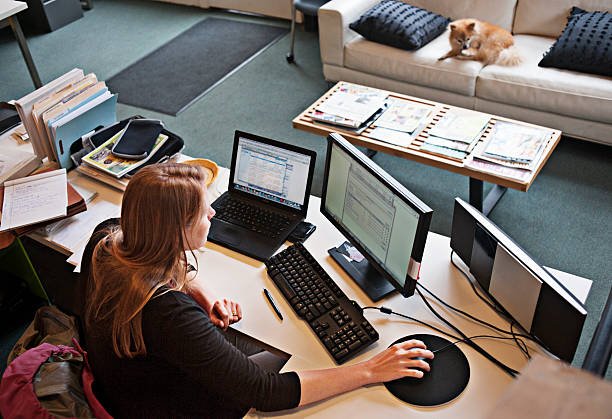Remote work is no longer a temporary solution—it has become a lifestyle. Since the global pandemic, millions of employees have shifted from traditional offices to work-from-home setups. But how is this affecting cities, businesses, and urban development in the long run? Let’s dive deep into the biggest trends and their lasting impact.

1. The Great Migration: People Moving Away from Big Cities
Why Are People Leaving?
- High cost of living in major cities like New York, San Francisco, and London.
- Better quality of life in suburban and rural areas.
- More affordable housing options in smaller cities.
- Desire for more space, especially after experiencing lockdowns.
Impact on Urban Areas
- Decreasing demand for apartments in city centers.
- Local businesses relying on office workers struggling to survive.
- Real estate prices dropping in some major metros while rising in smaller towns.
2. The Rise of Digital Nomads: Work from Anywhere Culture
Who Are Digital Nomads?
- Remote workers who travel frequently while working online.
- Professionals who have embraced the flexibility of remote jobs.
- Freelancers, entrepreneurs, and even full-time employees who work from different locations.
Effects on Cities and Tourism
- Increased demand for short-term rental properties (Airbnb boom).
- Rise of co-working spaces in tourist-friendly destinations.
- Cities like Bali, Mexico City, and Lisbon becoming remote work hubs.
3. Commercial Real Estate Crisis: The Death of Office Spaces?
Declining Demand for Office Spaces
- Companies downsizing or eliminating office space to cut costs.
- Hybrid work models reducing the need for full-time office use.
- Empty office buildings affecting urban property values.
New Uses for Empty Office Buildings
- Converting office buildings into residential apartments.
- Repurposing spaces for coworking hubs or community centers.
- Some cities offering tax breaks to businesses using vacant spaces creatively.

4. Changes in Urban Transportation Trends
Less Commuting, Fewer Cars
- Decline in public transportation usage.
- Lower traffic congestion in major cities.
- Reduction in pollution levels due to fewer daily commuters.
New Challenges
- Declining revenue for public transport systems.
- Increase in suburban traffic due to more people living outside the city.
- Governments investing in bike lanes and pedestrian-friendly infrastructure.
5. The Shift in Local Business Economy
Who’s Struggling?
- Restaurants, cafes, and bars that relied on office workers.
- Dry cleaners, gyms, and retail stores in business districts.
- High-end commercial real estate firms.
Who’s Thriving?
- Home improvement businesses (furniture, internet services, etc.).
- Delivery services and online grocery platforms.
- Local suburban businesses gaining more customers.

6. Tech Boom: Increased Demand for Remote Work Tools
Industries Benefiting from Remote Work
- Cloud computing services (Google Drive, Dropbox, AWS).
- Virtual collaboration tools (Zoom, Slack, Microsoft Teams).
- Cybersecurity firms protecting remote networks.
- Home office equipment providers (standing desks, ergonomic chairs, etc.).
7. Governments React: Policy Changes for Remote Workers
How Governments Are Adapting
- Some cities offering incentives for remote workers to relocate (Tulsa Remote program in the U.S.).
- Tax implications for employees working across different states or countries.
- New labor laws defining remote work rights and benefits.
8. The Social Impact: Isolation vs. Work-Life Balance
Benefits of Remote Work for Mental Health
- Flexibility in work hours reducing burnout.
- More time with family and personal activities.
- Improved work-life balance leading to higher job satisfaction.
Downsides of Remote Work
- Increased feelings of loneliness and isolation.
- Lack of social interaction affecting mental well-being.
- Challenges in creating a strong company culture remotely.

9. The Evolution of Workspaces: The Future of Offices
New Office Trends
- Hybrid work models: Employees coming in 2-3 times a week.
- Co-working spaces replacing traditional office setups.
- Smart offices with advanced technology to support hybrid teams.
Will Traditional Offices Disappear?
- Experts predict that offices will remain but in a more flexible form.
- Companies may use offices for collaboration and team-building activities instead of daily work.
- More businesses adopting “hot-desking” instead of assigned desks.
10. What’s Next? The Long-Term Future of Remote Work
Predictions for the Next Decade
- Remote work becoming a standard rather than an exception.
- More cities redesigning infrastructure to accommodate remote workers.
- Growth of global talent pools as companies hire from anywhere.
- Potential increase in VR and AI-powered remote work solutions.
Final Thoughts
The shift to remote work is reshaping cities, businesses, and even our personal lives. While some industries and urban areas struggle to adapt, others are thriving in this new digital era. The question remains: how will cities continue to evolve in a world where going to the office is no longer the norm?
Corporate America’s Mental Health Revolution: Why Every Employee Wins!






